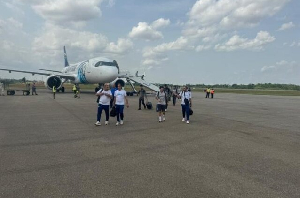- Home - News
- TWI News | TV
- Polls
- Year In Review
- News Archive
- Crime & Punishment
- Politics
- Regional
- Editorial
- Health
- Ghanaians Abroad
- Tabloid
- Africa
- Religion
- Election 2020
- Coronavirus
- News Videos | TV
- Photo Archives
- News Headlines
- Press Release
Opinions of Friday, 11 January 2008
Columnist: Bolus, Mercy Adede
Who actually uses our Railway system?
Many have never tried using the Ghana railway system and hence use the the tro tro transportation system. Which group of people uses our railway system in Ghana if there is any at all?
Could it be worth exploring Germany and Australia railway system and its benefits?
As this area is not my speciality I rsearch and pick some areas to share with you in order for Ghana to start thinking seriously about trasforming our railway systems and maximise benefits to everyone thus freeing our road from congestion, unnecessary road traffic accidents and injuries.
The research, I found stated that with almost 1 million inhabitants, Cologne (Köln) is Germany's fourth largest city. It goes to to further explain the process. Please read on. In the 1960s, Köln decided to build an underground tram system (like Stuttgart or Hanover) instead of a full metro (like Nuremberg or Munich). The first underground stretch opened in 1968. Most subways in the city centre were built until 1974, and in the 1980s and 90s the tunnel networks was gradually expanded. Currently the network includes 44.5 km of metro-like routes, either underground, elevated (L13) or at grade. This is complemented by 48 km of conventional railway lines (Lines 16 and 18 to Bonn) and 94 km of tram routes. The total length of the network is 186 km. Only 12 % of the network are on routes shared with car traffic. The system is a true network with many lines sharing certain stretches. In 1994 it was decided that the east-west lines shown in red on the map will not be converted to Stadtbahn operation with high-floor vehicles. Instead new low-floor trams were acquired which offer the same accessibility (35 cm). From Dec. 2003, also the "ring lines" (shown in green) were added to the low-floor network, whereas all other lines will eventually be converted to Stadtbahn lines similar to the networks in Stuttgart or Frankfurt with high platforms (90 cm) and mainly separate right-of-way when running at grade. Most underground stations have been rebuilt with high platforms in recent years, but some still have low platforms only (e.g. Appellhofplatz-Zeughaus, Reichenspergerplatz). History of underground sections
Similarly through my research I found this piece that Australia have also cleverly used the topography to their advanatge.
Diversity
Spanning three time zones, and with roughly the same land mass as China or the USA, Australia is a continent of different climates, disparate topography and great distances. Australia is also distinctive as one of the most sparsely populated but urbanised nation in the world.
Australia is a continent of topographical variety and vast distances. For example, the train trip from Sydney in the east to Perth in the west spans 4,352 km, with much the same distance separating Australia’s northern and southern coastlines. Such journeys traverse mountains, deserts, rainforests, plains and snowfields.
Australia has a population of over 18 million people of whom almost 12 million live in 8 capital cities scattered around the coastal fringe. Nearly 80% of Australians live on the eastern seaboard. This demographic pattern established from the outset of European settlement, makes Australia one of the worlds most urbanised yet least populated nations. This situation posed special problems for Australia’s rail pioneers upon whose work the nations rail pioneer upon whose work the nation’s economic development depended.
Today, Australia has the benefit across the nation which satisfies large-scale demand for passenger and freight traffic in urban areas, and the needs of communities and industries in remote locations.
Australia features an astonishing range of climates: tropical heat and extreme humidity, monsoons and cyclones, arid deserts, sub tropical and temperate zones, and sub-zero mountain ranges. Over the years Australia’s railway engineers have become pre-eminent for their solutions to the challenges of climate diversity. They are renowned for their skill and experience in developing and operating efficient railway systems in tropical and desert areas.
Credentials
With an annual turnover in excess of $8 billion and employing approximately 75, 000 people the Australian Railway Industry is one of the most modern and sophisticated in construction and consultancy services, but also in the innovative engineering solutions to combat a variety of physical, economic and technical challenges.
Innovation
In the 19th Century, Australia’s economic future depended on the development of an effective and affordable rail network to connect the nation’s emerging primary industries with their domestic and overseas markets. Australia’s topography, climates, distances and scattered communities meant that this challenging goal could only be achieved by innovative engineering.
This tradition of finding a better way remains integral to the success of an engineering environment where the imperative is to achieve cost effective railway solutions over vast distances and extremely arduous operating conditions.
Design and Manufacturing
There are seven rollingstock manufacturers in Australia, each experienced in the design of short and medium runs of customised locomotives, a full range of freight wagons, passenger coaches, double and single-deck electric and diesel multiple units.
This industry is also self-sufficient in the development and supply of a wide variety of components such as cast and fabricated bogies, wheels, and axles. The component range also includes track supplies, brake pads and blocks, pantographs, traction motors, specialised air-conditioning units, centralised traffic control systems, electronic and solar powered remote area signalling.
In Australia, tracks vary from the relatively lightweight variety used in the transportation of sugar cane to the heavy tracks designed for Australia’s iron ore railways. Track maintenance equipment covers the full range from hand-held power tools to fully computerised 60 metre long track relaying machines.
Network Development
Australia's public and private railway network currently comprises a total of 37 000 kms of multi-gauge tracks. Over the past 2 decades some rural networks have been rationalised, but many thousands of kilometres of new track have been built to satisfy the increased demand for freight and passenger services.
• New lines created to open up coalfields in Queensland, and iron ore deposits in Australia's north west;
• New lines have been built and more are planned to develop the capacity of Sydney and Brisbane's urban systems. In Western Australia, Perth's new northern electrified line represents an excellent example of world-class integrated transport planning;
• Work is currently underway on a billion-dollar upgrade of the Brisbane to Cairns rail link;
• Improved signalling and train control systems have been developed and introduced to increase train capacity. Industry Services
Over the years, Australia’s railway industry has developed specialised expertise and acquired extensive experience in all aspects of the design, development, construction, operation, maintenance and refurbishment of modern rail systems. The industry’s engineers have a proud record of achievement- particularly heavy haul networks in remote locations and hostile environments. The industry’s consultancy skills include feasibility reviews, route surveys, planning, detailed design, project management, estimating, financial analysis of options, infrastructure reviews, passenger reservation systems, and information technology.
The services of Australia’s public and private railway professional are available to transport authorities overseas as consultants, advisors, agents and supervisors in dealings with Australian manufacturers and suppliers.
Australian railway consultants have completed numerous projects such as transport planning in Eastern Europe and Asia, benchmarking in Hong Kong and the UK, train simulation, signal planning and supervision, as well as privatisation projects in Australia.
Performance
Australia’s rail networks operational performance is impressive by any standard. Every year, more than 500 million tonnes of fright is hauled and 650 million passenger journeys completed.
Areas of Special Expertise
Heavy Haulage Railways
Australia has established a worldwide reputation for the development of heavy haulage railways. These single-line networks carry some of he world’s heaviest and longest freight trains whose diesel-electric locomotives haul in excess of 130 million tonnes of iron ore every year. In Queensland, over 120 million tonnes of coal is hauled annually. This performance is achieved by electric locomotives which haul 100 tonnes per train and have been substantially designed and built in Australia for Queensland’s exacting tropical conditions.
Collaborative R&D
Australia's research and development achievements include the following collaborative breakthroughs:
• Wheel-rail interface developments, particularly wheel grinding techniques trialled throughout Australia and Hong Kong
• Ultrasonic and stress testing in rails;
• Computer simulations, particularly train path simulations;
• Signalling for automatic train protection and control systems;
• Head hardened rail to lengthen the life of heavily loaded rails. Light Rail Systems
The cities in Melbourne, Victoria, Sydney NSW, and Adelaide, South Australia all have a light rail system as well as conventional (‘heavy’) urban railways. Melbourne’s light rail network covers 236km of street and reserved-track lines, and operates 800 cars over more than 40 routes. This 1435mm gauge system, which is fully integrated with Melbourne’s heavy railway and bus service, is the largest and most economical network of its type in the developed world.
Australia’s light rail technology, skills and back-up services are available for export.
Tramways
Australia has developed and operated some of the largest and most sophisticated agricultural and mine tramways. This technology is available as a complete materials-handling system, as modular equipment, or as parts.
Leading Edge Technology
Examples of Australian technical innovations include the development and introduction of:
• High-speed bogie design for passenger and freight trains; • Computer information, technology for rail signalling, ticketing and training;
• Cost control and planning systems;
• Dry brake fuelling systems; pollution control environmental systems: carriage cleaning systems;
• Simulators for driver training and train operating; • Optical techniques for monitoring rail conditions, and measuring rail head wear.
What is Ghana waiting for. Why are we suffering on our road with people dying due to our lack of shabby rail way system failure and focusing on building of more roads with lack of road maitenance strategies.











